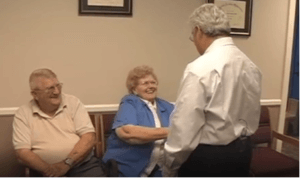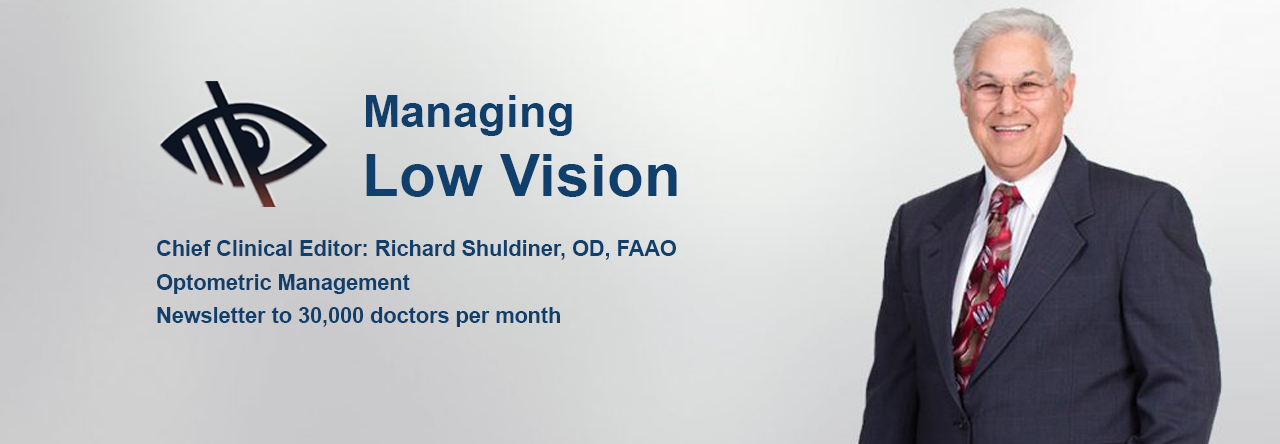By Richard J. Shuldiner, OD, FAAO, FIALVS, Chief Clinical Editor
The low vision exam can be conducted in many ways as each low vision doctor has developed his or her own sequence and/or procedures. However, the ultimate result should be the same: the patient leaves better than they came in and can now do some or all of the tasks they could not do before.
It is critical to understand that, for the most part, low vision care is about function, not seeing. The definition for low vision I use is: best-corrected vision which is insufficient to do what you want to do. Therefore, the low vision patient must have specific goals of tasks they want to do, or they are not a low vision patient.
The Shuldiner 12 Step Low Vision Evaluation was developed to meet the needs of the vision loss patient in the private practice setting. It takes one hour to complete. Each step has a specific purpose in sending that patient home better than they came in.
This multi-part series will explain each part so that you, the referring practitioner, will understand what your patient should expect when you refer the patient for low vision care. I teach this 12 step method in a 5 day intensive training course and all of the members of The International Academy of Low Vision Specialists (www.IALVS.org) have completed the course.
Step One: Creating Relationships
Vision loss patients are upset.
Most upsets are caused by unfulfilled expectations and thwarted intentions. No one expects to lose vision. And everyone has expectations and intentions for their retirement years. Unfortunately, that’s when vision loss strikes most people. Age-Related Macular Degeneration is the leading cause of vision loss in those over age 65.
People expect to see and expect to enjoy their later years reading, traveling, doing hobbies, enjoying grandchildren, and more. When vision loss occurs, they expect the doctor will fix it somehow, with glasses, medicine or surgery. When told their condition has no cure, the vision loss is permanent and could get worse, major upset occurs. Depression often occurs as well.
When they are referred to Low Vision, they can be in a number of places emotionally. But for sure they have, in their mind, another eye exam. One must remember that the vision loss patient has undergone a multitude of eye examinations including dilation, bright lights, injections in the eye, “which is better” questions, and more. So, they have false expectations of what this eye exam will entail. In addition, they have been to many other types of doctors and have expectations of what “another” visit to a doctor will be like. My job is to interrupt those expectations.
In my opinion, the low vision exam must present as a completely different experience from the traditional eye and other doctor exams they have undergone. I want it to be “success” oriented.
The Past
While human beings live in the present, the past is right there with us. The past influences the present virtually every moment, in every experience, and in every decision. For example, even in a simple task like buying a pack of gum, the past is right there. Before your hand reaches the desired pack, the brain has already compared the past experiences of what gum you liked and what gum you did not. Those past experiences help you decide the present decision.
How do I “break” the mold of the past doctor/eye doctor experiences so I can start fresh? For one, I have NO forms to fill out. None. First of all, they are visually impaired so why would I want to irritate them with a reading/writing task? Secondly, they get embarrassed if someone else must fill out the forms for them. It only serves to demonstrate their lack of independence, which is why they are coming to me in the first place.
Next, I, the doctor, go into the waiting room to greet the patient and introduce myself to whoever is with them. What doctor does that? I request their eyewear so I can neutralize their Rx and see what other aids they have tried. I leave them for that task and then return to retrieve them myself and escort to the exam room.

I never allow a staff member to seat the patient in the exam room. It is an opportunity for me to see how the patient navigates their surroundings and to evaluate their mobility.
With regards to a friend or family member (the third person in the room) being present during the exam, I always prefer to have them observe. More memory in the room always helps. And that person gets to see how their loved one is functioning and how helpful the low vision devices are.
However, one must not assume it is okay with the patient to have them in the room. To avoid an issue, I simply say to the patient, come with me, and let’s go to work. I watch to see who follows. If the third person gets up and follows, I simply allow it. If just the patient follows me, I wait until they are seated before I recommend we bring that third person in. If I’m asked by the third person if they can come in, I turn to the patient and say, “it’s completely up to you” and wait for their answer. But I always recommend to the patient that they have someone with them during the exam.
In conclusion, I seek to create a relationship of understanding what they are going through and have them see that the low vision evaluation will not be like any other doctor visit they ever had. Now I can do the evaluation without the past in the way.
In part two of this series, The Low Vision Exam: What Your Patient Can Expect, we will discuss the “opening statements” that allow for the evaluation to be completed in one hour or less.

